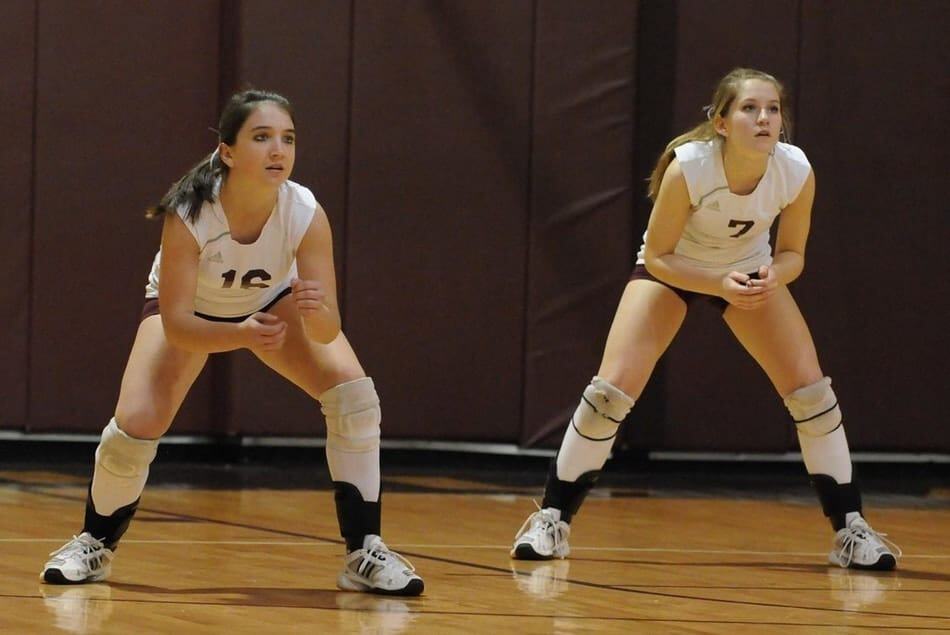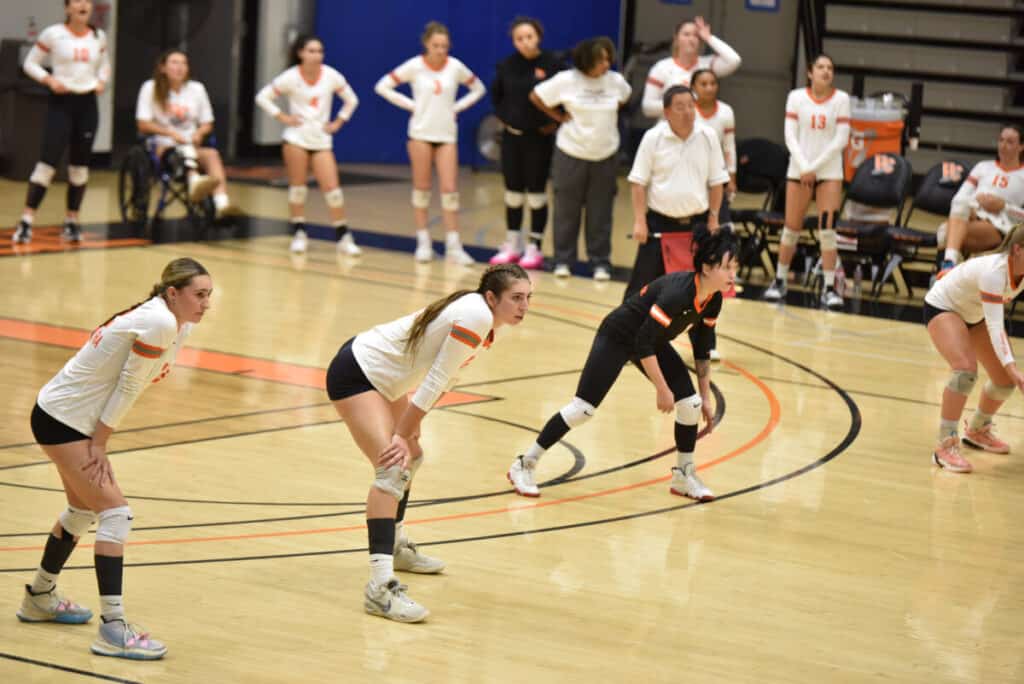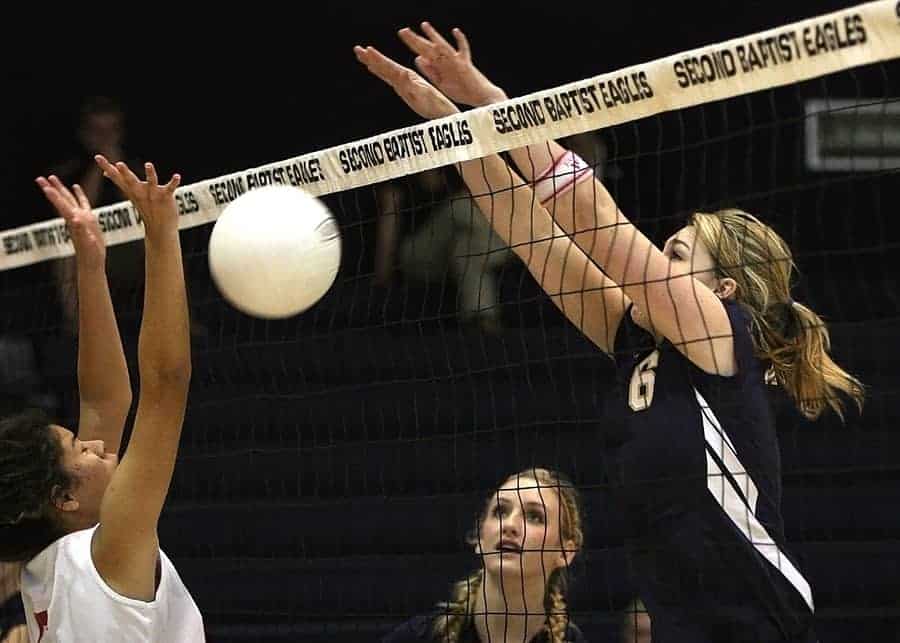I played volleyball for years before ever considering that it has two parts: offense and defense. Your team is playing both defense and offense nearly every time the ball crosses the net.
How do you play the defensive position in volleyball? To play defense in volleyball you need the right mindset, positioning, understand “down and ready”, know how to dive, and know how to read the other team.
With most sports, it’s very clear when your team is on offense and when you’re on defense. In football, they are totally different groups of players and they take turns being on the field. In baseball, your whole team goes to the dugout. In volleyball the switch between offense and defense happens so often and so quickly, it’s easy to overlook it.
Defensive Basics
Defense in volleyball is receiving or recovering the ball when it crosses the net. Whether it’s a serve, a spike, a tip or a freeball, when you are taking the first touch on the ball after it crosses the net, that’s defense.

The positions in volleyball that are focused on playing defense are the libero and the defensive specialist. As far as the area on the court, the defense is primarily the back row.
The front row is really just responsible for covering tips and hits that would come straight down in the front. They are blocking, which is also part of your team’s defense, but once it gets past the block, the vast majority of the attacks will be handled by the players on the back row.
Defensive Mindset
To be an effective part of the defense, you need a certain mentality. It’s easy to see and relate to players that are competitive on offense. We see a great kill or an ace and we all cheer and we can see that player’s competitive drive.
Playing defense requires just as much competitive spirit, if not more! Good defensive players take great satisfaction and pride, not in scoring a point, but from denying their opponents the point.
“You’re not making this point. Not here, not now, not on my court.
– The ultimate defender
I don’t care if I have to run, jump, dive, roll or slide. Even if I have to crash into the scorer’s table or the bleachers, you’re not scoring on me.”
So what do you get for all your trouble? When you make that great dig or save, you get the thrill of knowing that you just stole their moment. They made their best attack and your stopped them! Good defenders can force the other team into frustration just by keeping the ball from hitting the floor.
Defensive Positioning in Volleyball
Playing defense requires being in the right position to cover your part of the court when the time comes. There are 2 main ways that players and coaches plan to defend, either with 3 defenders, or only 2.
Three Defenders
When there are 3 defenders, usually the one in the middle needs to play a little deeper and is really responsible for covering the endline all the way to the corners. The players off to the side a closer to the middle of the side of the court and they are responsbile for covering their sideline.

When receiving the serve, you may see 4 players in the back court and think they are all playing defense. This is almost never actually true. Depending on the team’s skills and rotation, the 4th person on the back row is being “covered up” by another defender so that they don’t have to take the first touch on the serve. This is usually to prevent the setter from having to play the serve, which means they’ll be free to take the second touch and set up the attack.
Two Defenders
The second most common strategy to defend, is to have just 2 players defend the back half of the court. While this may seem like a disadvantage, good defenders can cover a lot more space on the court than you might think.
This can be very effective when you have 2 strong defensive players on the back row together because it allows 4 players to focus on attacking and blocking. While only 3 of the players can technically be on the front row of the roration and able to attack, don’t forget that the setter may be in the back row rotation, and able to play up in the front.

Bringing four players to the front court gives your setter as many weapons and opportunities as possible to create an attack that’s close to the net.
“Down and Ready” Position in Volleyball
If you’ve ever watched a volleyball game, you see that players spend a lot of time in a hunched-over squat position. Every sport has certain positions you take at particular times to get ready for the coming action.
In volleyball, the most common and basic stance is called “down and ready”. Players stand with their feet pretty far apart, in a position that’s sometimes called a quarter-squat. They have their arms

You may see players reach down and kind of touch or sweep the floor with a finger. This is a habit that they’ve been trained to do, to make sure they are squatting down low enough to be ready for the serve or hit.
Players don’t just use this position when getting ready for serve receive, they transition back to this stance frequently throughout rallies. Any time the other team is about to attack your team should be prepared by making sure they’re in the best location they can get to and get down and ready.
Would you like to learn about how to play a freeball in volleyball?
Diving in Volleyball
There are different dives that are taught for different situations. Here are a few:
Barrel Roll – This dive is for when you have to move out of your reach to the side. You lunge sideways while keeping your platform solid until you contact the ball. Tuck your outside knee and roll onto your hip and roll back into a crouched position to recover quickly.
Dolphin – This dive starts with diving onto your arms while kicking up with your feet. You are kicking your feet to get more speed and momentum toward the ball.
Collapse – In this dive you start in ready position, reach your platform to the floor, collapse your platform by bending your elbows, then slide forward across the floor to get under the ball.
Pancake – The pancake is a desperation

READ Your Opponents
When you are in “
So focus on:
Where is their body momentum leading them?
As the server is tossing the ball or the hitter is making their approach, how is their body momentum moving? How quick are they coming? With hitters especially, their approach takes several steps and seconds, they can’t change their direction at the last second, use that to help predict where they’re going to try to send the attack.
Which way are their shoulders facing?
Players are taught to square their shoulders to their target for good reason: it helps you deliver consistent, accurate strikes. As a defender, use that information to help predict where the ball is coming. Some hitters will be crafty and fake you out, but the majority of the time, hitters will be doing what they’ve been taught to do over and over.
What is their timing (how high is the toss or set)?
Make sure to pay attention to the height of the toss or set, and the speed that they are approaching. Timing your dig or pass doesn’t just start when the ball crosses the net, but as you are watching the opponent make contact.
How is their arm approaching the ball?
As your opponent is about to make contact, how is their arm motioning toward the ball? Did they take a full backswing or not?
How is their hand making contact with the ball?
Is their hand open with their fingers spread? This would mean they’re trying for a floater. Are they wrapping their hand over the ball? Flicking their wrist? What if they pull that sneaky move where they lead up to the ball as if they are going to slam it and then do a gentle little tip? Will you be ready?

You must gather every detail of this information and be able to take action on it immediately. Great defensive players can be amazing to watch. When you watch a libero pick up hit after hit it can just seem like luck or amazing reflexes.
The truth is amazing defensive plays come from the player filtering all the information available and putting themselves in the most likely position and preparing for the most like ball trajectory. Then, as the play progresses, they adjust to the changes as they happen. It doesn’t make it easy to play defense, but this gives you a much greater chance of being able to react in time.
Related Questions
What Are The Positions In Volleyball?
The positions in volleyball are: setter, libero, defensive specialist, outside hitter (also called left side hitter), opposite hitter (also called right side hitter) and middle blocker (sometimes called middle hitter or center).
What Is The Difference Between Libero and Defensive Specialist?
The libero wears a different colored jersey and has a unique set of rules. They are allowed unlimited substitutions but limited to the back row and they can never make an offensive hit from above the plane of the net.
The defensive specialist is substituted for front row players that are weak on defense. They can come in for any player and can play the front row when needed.
Are Liberos Usually Short?
There’s not a rule that liberos need to be short, but there is a strong tendency for coaches to choose shorter players to play the libero role. Since libero is a role that can’t play front row, and can never attack the ball above the net, why would you use one of your taller players who can hit well to play a role in the back? Shorter players also have a tendency toward getting lower more easily and quickly and having the agility to react on defense.
Recent Posts
Athletes, listen up! Do you have a closet full of old jerseys, sweatpants, and tees that you just can't seem to part with? Well, dust them off, because you're sitting on a goldmine of fashion...
You may have heard, or you may have noticed, that there's been a change to the rule about double contact in volleyball. In 2022, an experimental rule change began to be implemented, where the double...
